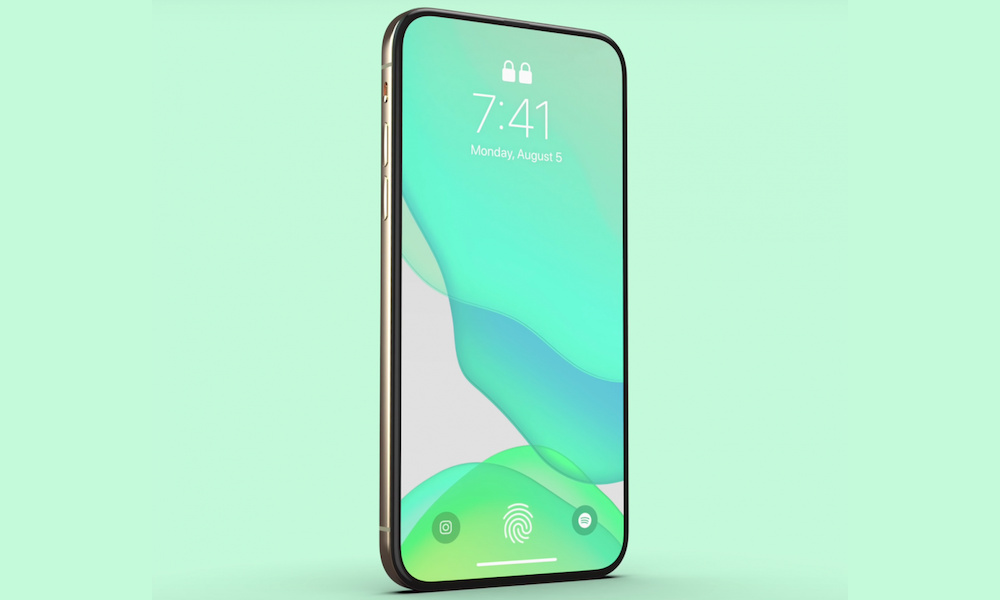More Reports Suggest In-Display Touch ID May Finally Come to the ‘iPhone 13’ This Year
 Credit: EverythingApplePro
Credit: EverythingApplePro
Toggle Dark Mode
We’ve been hearing reports for years that Apple has been working on new technology to place a fingerprint sensor directly into the iPhone’s display, and while it’s been a long time coming, it looks like this may be the year the feature finally arrives.
In fact, the rumours of in-display Touch ID actually pre-date Face ID, with reports as far back as 2017 suggesting that the upcoming “iPhone 8” would adopt it as a way of eliminating the traditional Home button. Of course, we now know that the “iPhone 8” was what actually became the iPhone X, and that Apple has something much more revolutionary up its sleeve.
Although the advent of Face ID led some to believe that Apple had given up on an in-display fingerprint sensor, it looks like work on the idea never stopped, with various reports suggesting that either Apple would implement it for a lower-cost iPhone model, such as the iPhone SE, or that it would be introduced as a companion to Face ID, rather a replacement for it.
Of course, at this point rival smartphone manufacturers have already beaten Apple to the punch in incorporating various in-display fingerprint sensors, but Apple is never a company that cares so much about doing things first as it does about doing them well. It’s a trend that we already saw with Face ID, which blew away the two-dimensional facial recognition systems that came before, which could often be fooled with a photograph, and there’s every reason to believe that Apple is going to do the same with its new in-display Touch ID, and we already know it’s working on some pretty cool ideas.
Closer to Reality
Last month, Bloomberg’s Mark Gurman reported that in-display Touch ID would be coming to this year’s mainstream iPhone models, although he also suggested that it would be one of the few marquee features in an update that would become the “iPhone 12S” rather than the “iPhone 13.”
Gurman emphasized that the new in-display Touch ID feature would complement Face ID, allowing more options for unlocking the iPhone, especially in environments such as health care where people are regularly wearing masks.
While Gurman’s information is already pretty reliable, a second reputable source has weighed in on this latest rumour in the form of The Wall Street Journal’s Joanna Stern, who actually dropped the information while discussing features of Samsung’s new Galaxy S21, which reportedly packs in a new and improved in-display fingerprint sensor.
According to Stern, who was discussing which of these features could and should be coming to the next iPhone, two former Apple employees confirmed that Apple is indeed working on in-screen fingerprint technology for the next iPhone, however it’s taking the time to make sure that it builds a solution that’s both reliable and secure.
Optical vs Ultrasonic
One of the most likely reasons that Apple didn’t debut in-display Touch ID years ago is because until recently, most of these solutions have relied on purely optical sensors, which relied on a two-dimensional scan. In other words, a photocopy of a fingerprint could trick these sensors in much the same way that early facial recognition systems could be fooled by holding a photograph up to a smartphone camera.
Unlike most of its smartphone rivals, however, Apple has a lot more at stake when it comes to its authentication systems. For instance, Touch ID powers Apple Pay, and it’s not insignificant that Apple’s mobile payment technology arrived after Touch ID became a standard feature.
So, any new in-display fingerprint sensors need to be least as secure and reliable as the existing Touch ID home button, which can use capacitative sensors that generate a fingerprint data map uniquely, rather than a straight image.
Similarly, ultrasonic in-display fingerprint sensors (also known as acoustic sensors) use sound waves to create a 3D map of a person’s fingerprint, making them considerably harder to spoof.
As a bonus, since these sound waves aren’t affected by moisture in the same way that the capacitive home button sensor is, they also work better with sweaty fingers.
While several sources have suggested that Apple is looking at purely ultrasonic technology, however, Stern’s sources have indicated that Apple is working at least partially on optical sensor technology, although that could be part of a hybrid optical-capacitive sensor, or even an entirely new Apple-engineered optical-acoustic design.
At this point, it’s also likely that Apple may still be considering two or more different sensors and hasn’t yet reached a final decision. While ultrasonic technology would likely be the best choice, it’s considerably more expensive to implement, which might require Apple to limit it to the higher-end Pro models. However, as we’ve seen with past rumours of Apple’s projects, it’s equally possible that the company is working on multiple implementations, with a more advanced sensor already in the works for a 2022 or 2023 iPhone model.
Either way, it looks like a very real possibility that Touch ID will be making a return to the flagship iPhone lineup this year, and while this will be a boon for everyone who has struggled to unlock their iPhone while wearing a mask, we’re also optimistically hoping that will be far less of a concern by the time the 2021 iPhone arrives this fall.
[The information provided in this article has NOT been confirmed by Apple and may be speculation. Provided details may not be factual. Take all rumors, tech or otherwise, with a grain of salt.]






